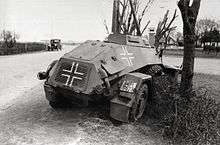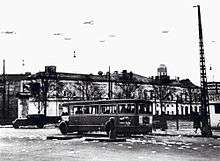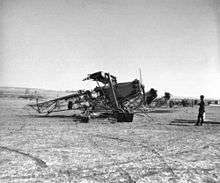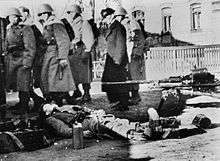German invasion of Denmark (1940)
| German invasion of Denmark | |||||||||
|---|---|---|---|---|---|---|---|---|---|
| Part of Operation Weserübung | |||||||||
Map of Denmark showing German plans | |||||||||
| |||||||||
| Belligerents | |||||||||
|
|
| ||||||||
| Commanders and leaders | |||||||||
|
|
| ||||||||
| Strength | |||||||||
|
14,500 soldiers in the |
Höheres Kommando XXXI:[4] 527 aircraft of the X. Fliegerkorps[5] | ||||||||
| Casualties and losses | |||||||||
|
26 killed[6] 14 aircraft damaged |
20 killed and wounded[7][6] 2 captured 12 armoured cars destroyed or damaged 4 tanks damaged 1 aircraft damaged[7] 1 tugboat sunk[8] | ||||||||
The German invasion of Denmark was the fighting that followed the German army crossing the Danish border on 9 April 1940 by land, sea and air.
Lasting approximately six hours, the German ground campaign against Denmark was one of the shortest military operations of the Second World War.[9]
Background
The attack on Denmark was planned as a part of the German Operation Weserübung Süd – the German plan for an invasion of Norway. The purpose was mainly to secure the iron ore shipping from Narvik. In order to capture Norway, the Germans had to control the airfield outside Aalborg in northern Jutland. [10] The Luftwaffe high command was in favour of occupying Denmark in order to extend the German air-defence network northwards, making it harder for British bombers to outflank the system from the north when attacking cities in Germany.[11] Additionally, the Norwegian fjords also provided excellent bases for German submarines to attack in the North Atlantic.
German plan of attack
The German High Command planned for a combined assault on Denmark to overrun the country as swiftly as possible, with an airborne assault on the Aalborg airfields and a surprise landing of infantry from naval auxiliaries at Copenhagen in addition to a simultaneous ground assault across the Jutland peninsula.[12]
On 4 April, Admiral Wilhelm Canaris, the chief of the Abwehr and involved in the German resistance to Nazism, warned the Danes of an imminent invasion.[13]
Skirmishes
Although the Danish Army had been forewarned of the attack, it was denied permission to deploy or prepare defensive positions as the Danish government did not want to give the Germans any provocation for their actions. All that was available to meet the land invasion were small and scattered units of the frontier guard and elements of the Jutland division. Believing attack was imminent, the troops were placed on full alert at 13:30 on 8 April.[14]
Fighting in Jutland
The Danish border was breached at Sæd, Rens, Padborg and Krusaa at 04:15. With the Kriegsmarine (navy) simultaneously landing troops at Lillebælt, the troops at the border were cut off at the beginning of the fighting. The alarm was sounded at 04:17, and the first Danish troops were dispatched at 04:35.[14]
Eastern flank
Lundtoftbjerg
The first clash between the Danish Army and the invading forces occurred at Lundtoftbjerg, where a Danish anti-tank platoon armed with two 20 mm guns and a light machine gun had taken up positions covering the road. A German column appeared at 04:50, and the 20mm cannons opened fire on the armoured cars while the machine gun took aim at the motorcyclists.[14] A fire started in a nearby barn, filling the air with smoke and hindering the German's advance. Eventually the anti-tank platoon was forced to withdraw to Aabenraa. About 1.5 km to the north, a bicycle platoon had prepared a defence of a railway bridge. Fire from the armoured cars and strafing fighter aircraft forced the Danes to retreat, and a third of the men were captured.[14] The Germans lost two armoured cars and three motorcycles, while the Danes suffered one dead and one wounded.
Hokkerup
Another German column reached Hokkerup a few miles east of Lundtoftbjerg at 05:30. They also encountered a roadblock made with farm equipment, set up only 20 minutes before by 34 Danish soldiers.[15] The Danes knocked out the three leading armoured cars, forcing them to pull back. The Germans set up a 37 mm gun 300 meters away, but it only managed to fire one round before being knocked out by two rounds from a 20mm gun.[14] Hand-to hand combat ensued in which one Dane was killed and three wounded, one fatally.[14] With air support, the 100 or so Germans managed to surround and capture the Danish unit at 06:15.
Bjergskov
Seven kilometers north of Lundtoftbjerg, one motorcycle and two bicycle platoons arrived at Bjergskov at around 05:00. Under Lieutenant colonel S.E. Clausen the motorcycle troops set up a roadblock with two 20 mm guns while the remaining platoons spread themselves out in the woods.[14] A German column arrived at 06:30. Their tanks pushed the roadblock aside and opened fire. One gun returned fire until a tank drove over it. The gunner attempted to run for cover in the woods but was killed when a German aircraft strafed the road. The second gun malfunctioned. The Danes tried to escape on motorcycles[16] but the Germans then surrounded them with armoured vehicles and captured them.[17] A further four Danish soldiers were wounded, while one German armored car was damaged.[14]
Central thrust
Bredevad

In an encounter between Danish and German forces at Bredevad, 10 km north of the border, a German vanguard of four armoured cars approached the village. The Danes arrived at 6:30 AM. Not even having time to build a roadblock, they took cover in a garden and opened fire.[18] A machine gun and a 20 mm cannon manned by one and a half platoons fired warning shots. Ignored by the Germans, the Danes then opened fire from 300 meters out, knocking out the lead armoured car and killing its driver. A short skirmish followed. The Danes knocked out three more German armoured cars and suffered four casualties. At 07:15 a reinforcing German motorized column arrived from Tinglev, cutting the Danes off and forcing them to surrender. Two Danes were killed and five were wounded.[14]
Rabsted
A cyclist platoon from Korskro arrived at Rabsted at 6:45, occupying the town. While lying in wait, they managed to capture two German dispatch riders. Learning from them that Bredevad had been taken, the platoon retreated to the north-east via secondary roads.[14]
Aabenraa
As the Danish forces at Søgaard army camp were preparing to pull back north to Vejle where the main force of the Jutland Division was preparing for battle, a short skirmish developed at Aabenraa as the anti-tank platoon from Lundtoftbjerg attacked the 15 or so pursuing German vehicles.[19] After disabling a German tank, the rearguard pulled back to Knivsberg. They rendezvoused with a bicycle platoon from Stubbæk Skov, which had suffered one killed and three wounded to German aircraft.[14] The Danish CO ordered them to northern Haderslev.
Haderslev
.jpg)

Haderslev had a garrison of 225 men of the Jutland Division under Colonel A. Hartz, which defended both the barracks in the town and the road leading into it. Troops in the town mobilized at 07:00 upon hearing instructions that were broadcast from police loudspeaker vans.[14] Bolstered by retreating units, there was an approximate total of 400 Danes defending the town. Three roadblocks were set up; one consisted of dumping wagons, two were made of spare lumber.[14]
At about 07:50 the southern outskirts of Haderslev, a Danish 37 mm anti-tank gun with a crew of five attacked the approaching armour.[19] Two tanks lined up adjacent to one another and opened fire. The Danes landed all three of their shots -one in a tank's tracks- but two of the gun crew were killed and the rest wounded. One tank then drove over the gun. Just around the bend the wagon roadblock on Sønderbro Street covered by two 20 mm cannon and a machine gun put up resistance. The Germans laid down heavy fire and a Danish soldier was killed and two more wounded, but the Germans were effectively pinned down.[20] The fighting continued for ten more minutes until the order to surrender was received from Copenhagen by telephone. The Germans were then allowed to proceed into the town of Haderslev, but the Danish garrison stationed there had not received the order to surrender and fired on the Germans. Two German tanks and a motorcycle proceeded unsuspecting towards the barracks, which were defended by the anti-tank unit from Lundtoftbjerg.[14] They opened fire, killing the motorcyclist and blowing the tracks off one tank, sending it crashing into a house. However, the Danish garrison capitulated at 08:15 when the order to surrender from Copenhagen finally came through.[14] One Danish soldier was killed while defending the barracks;[14] three Danish civilians were killed in the crossfire.[21]
Western flank
Abild and Sølsted
The first fighting in Western Jutland occurred against the Tønder garrison, which was dispatched to Abild and Sølsted. At Abild, a Danish 20 mm gun crew knocked out two German armoured cars of the German 11th Motorized Regiment before pulling back. At Sølsted, a Danish anti-tank unit consisting of fewer than 50 men set up a defensive position with a 20 mm gun on a road. When a force of the German 11th Motorized Regiment approached, the Danes opened fire as soon as the first German armoured car came within range. The first vehicle was knocked out and ended up in a ditch, while the next continued forward, but pulled back after being hit. It was hit several more times, but was able to fire back. German infantry attempted twice to outflank the Danish positions, but both attempts were met with heavy fire and they became bogged down. Seeing that his attack was failing, the German regimental commander radioed for support. Three German Henschel Hs 126 aircraft soon appeared. The aircraft bombed and strafed the Danish force, until the Danish commander ordered his troops to fall back to Bredebo. In spite of this, no Danish casualties were reported.[14] When the men of the Tønder garrison reached Bredebro the order to capitulate had been issued and the fighting was over.
Airborne landings
At approximately 0500hrs the first attack in the world made by paratroopers took place. 96 Fallschirmjägers jumped from nine Junkers Ju 52 transport aircraft to secure Storstrøm Bridge, connecting the island of Falster with Zealand (Sjælland), and the coastal fortress on Masnedø island. The Germans expected heavy fighting around the fortress, but much to the surprise of the elite troops, only two privates and an officer were found inside.[22] The landing opened the way for a battalion of the 198th Infantry Division to advance on Copenhagen by land.[23]
75 minutes later hundreds of paratroopers landed in Aalborg, the main city of northern Jutland, in order to secure the main military target in the entire Operation Weserübung Süd: the airfield at Aalborg. This was planned to be the main stepping-stone to the invasion of Norway. The Fallschirmjägers did not encounter any resistance and in less than an hour, German aircraft began to land on the runways in huge numbers. More than 200 landings and take-offs were recorded on the first day, most of them transporting troops and fuel to Fornebu Airport in Norway.[24]
In Esbjerg, a 75mm anti-aircraft gun damaged a German aircraft.[14]
Naval landings
In order to capture the connections between Jutland and Zealand the Kriegsmarine landed more troops from the 198th Infantry Division at Funen.[23]
At the same time troops landed in Korsør and Nyborg, thereby cutting off the connections between Funen and Zealand. The troops in Korsør met no resistance and hurried towards Copenhagen which they reached at noon.[25]
A little before, at 0355hrs the Germans made a surprise attack on the southernmost city of Denmark, Gedser. The ordinary ferry from Warnemünde was crammed with German troops. Soldiers swarmed inland and cut telephone lines. Immediately afterward, armour and motorcycles followed, rapidly moving towards the Storstrøm Bridge to capture it together with the paratroopers.[26]
Capture of Copenhagen
.jpg)
To secure the quick surrender of the Danish authorities, the capture of the capital city was considered essential. At 0420hrs[27] the 2,430 ton minelayer Hansestadt Danzig, with an escort of the icebreaker Stettin and two patrol boats, entered Copenhagen harbour with battle flags flying. The harbour was covered by the coastal artillery guns of Fort Middelgrund; the newly appointed Danish commander ordered a warning shot to be fired, but the recently arrived recruits in the fort could not make the gun function.[28] After the landing of a battalion of the 198th Infantry at 0518hrs, the German forces captured the 70-strong garrison of the Citadel – the headquarters of the Danish Army – without firing a single shot. The next target of the German forces was Amalienborg Palace, the residence of the Danish royal family.[23]
Amalienborg and capitulation

When the German infantry arrived at Amalienborg they were met with determined opposition from the training company of the King's Royal Guard, which repulsed the initial attack and suffered three wounded. This gave King Christian X and his ministers time to confer with the Danish commander-in-chief General Prior. As the discussions were ongoing, several formations of Heinkel He 111 and Dornier Do 17 bombers from Kampfgeschwader 4 roared over the city dropping OPROP! leaflets. Faced with the explicit threat of Luftwaffe bombing the civilian population of Copenhagen, all but General Prior favoured surrender. Even without this to consider, Denmark's military position was untenable. Its land and population were too small to hold out against Germany for any sustained period. Its flat land would have resulted in it being easily overrun by German panzers. Jutland, for instance, was wide open to a panzer attack from Schleswig-Holstein to the south. Unlike Norway, Denmark had no mountain ranges from which a drawn-out resistance could be mounted.[29] The Danish government capitulated at 0600hrs[30] in exchange for retaining political independence in domestic matters.
Fate of the Danish Air Services

The entire four squadron-strong Danish Army Air Service was stationed at Værløse near Copenhagen. In anticipation of the German invasion, the squadrons had prepared to disperse to airfields all over the country, but this had not been accomplished by 0525 when Luftwaffe aircraft appeared over the airbase.[31] As the German aircraft reached Værløse, one Fokker C.V-E reconnaissance aircraft was getting airborne,[31] but was shot down by a Messerschmitt Bf 110 flown by Hauptmann Wolfgang Falck at an altitude of 50 metres. Both crew members were killed.[23][7] The German Bf 110s then strafed the base while coming under heavy anti-aircraft fire. They destroyed 11 aircraft and badly damaged another 14 as they taxied to take-off, wiping out most of the Danish Army Air Service in one action. The Danish Navy Air Service remained at its bases and escaped damage.
1st company of the 11th battalion

While most of the Danish Army followed the order to capitulate, one unit refused to give up. Colonel Bennike, the commander of the 4th Regiment based at Roskilde, believed that the order to surrender had been forced on the government by the Germans and that Sweden had also been attacked. Instead of surrendering, Bennike and his unit boarded the ferry in Elsinore to Sweden and went into exile. After the misunderstanding was later cleared up, some Danish soldiers stayed in Sweden while others returned to Denmark. Of those that remained, several would join the Danish Brigade in Sweden in 1943.[32]
Casualties

The German high command tried to present the attack on Denmark as a peaceful invasion in an attempt to score propaganda points, so it would be believed that Denmark did not put up any resistance against the invasion.[33]
Author Kay Søren Nielsen states in his first monograph, that in the archives of the Danish weapons manufacturer DISA ('Danish Industrial Syndicate'), 203 German soldiers are listed to be killed in Jutland.[34] In 2015, the Journal of Military History, Krigshistorisk Tidsskrift, published an article for the Royal Danish Defence College (RDDC), that has summarised significant key points in the German invasion of Denmark. The retired military correspondent Lt. Col Jürgensen H.J., argues that the actual German losses were 2-3 killed and 25-30 wounded, while the Danish military suffered a confirmed 16 dead and 20 wounded. The casualties among the civil resistance is not certain, but given as 10 dead and 3 wounded.[35]
Military historian David T. Zabecki notes in "Germany at War: 400 Years of Military History" that Denmark had suffered 49 casualties, or 26 killed and 23 wounded, and the German army lost 20 soldiers, killed and wounded.[6]
Apart from the casualties at the front, a few aircraft were shot down or crashed and a tugboat sank after a collision with another German vessel in the Great Belt.[8]
Aftermath
The Danes capitulated within six hours, resulting in a uniquely lenient occupation, as the Germans were content to leave the Aryan Danes to manage their own affairs. Danish soldiers were disarmed during the afternoon and those captured were allowed to return to their units.[14] The island of Bornholm was occupied without incident the following day by a single battalion.[36] The Royal Danish Army was severely reduced after the invasion, with only a 3,300-strong "Life Guard" unit allowed to persist.[37]
See also
- April 9th, a 2015 Danish film about a group of Danish bicycle infantry during the German invasion of Denmark.
References
Citations
- ↑ Dildy 2007, p. 16.
- ↑ Dildy 2007, p. 15.
- ↑ Dildy 2007, p. 22.
- ↑ Dildy 2007, pp. 18,28.
- ↑ Hooton 2007, p. 29.
- 1 2 3 4 Zabecki 2014, p. 323.
- 1 2 3 Hooton 2007, p. 31.
- 1 2 Lindeberg 1990, p. 98.
- ↑ Dildy 2007, p. 34.
- ↑ Lindeberg 1990, p. 8.
- ↑ Dildy 2007, p. 9.
- ↑ Dildy 2007, p. 12.
- ↑ Axelrod, Alan (2008). The Real History of World War II: A New Look at the Past (illustrated ed.). Sterling Publishing Company, Inc. p. 53. ISBN 9781402740909.
- 1 2 3 4 5 6 7 8 9 10 11 12 13 14 15 16 17 18 19 Finsted 2004.
- ↑ Lindeberg 1990, p. 46.
- ↑ Lindeberg 1990, p. 48.
- ↑ Lindeberg 1990, p. 50.
- ↑ Lindeberg 1990, p. 52.
- 1 2 Lindeberg 1990, p. 42.
- ↑ Lindeberg 1990, p. 61.
- ↑ Lindeberg 1990, p. 63.
- ↑ Lindeberg 1990, p. 31.
- 1 2 3 4 Dildy 2007, p. 36.
- ↑ Lindeberg 1990, p. 75.
- ↑ Lindeberg 1990, p. 32.
- ↑ Lindeberg 1990, p. 28.
- ↑ Lindeberg 1990, p. 9.
- ↑ Lindeberg 1990, p. 14.
- ↑ Shirer 1990, p. 663.
- ↑ Lindeberg 1990, p. 23.
- 1 2 Schrøder 1999, pp. 109,113.
- ↑ Nigel 2014, p. 5.
- ↑ Lindeberg 1990, p. 79.
- ↑ Nielsen 2005.
- ↑ Jürgensen 2015, pp. 16-25.
- ↑ Ziemke 1959, p. 60.
- ↑ Nigel 2014, p. 6.
Bibliography
- Dildy, Douglas C. (2007). Denmark and Norway 1940: Hitler's boldest operation. London: Osprey Publishing Ltd. ISBN 978-1-84603-117-5.
- Hooton, Edward R. (2007). Luftwaffe at War; Gathering Storm 1933–39. London: Chervron/Ian Allan. ISBN 978-1-903223-71-0.
- Jürgensen, H.J. (2015). Krigshistorisk Tidsskrift, 51. årgang, nr. 1, marts 2015. København.
- Lindeberg, Lars (1990). 9. april; De så det ske (in Danish). Denmark: Sesam. ISBN 87-7258-504-8.
- Nigel, Thomas. (2014). Hitler’s Blitzkrieg Enemies 1940: Denmark, Norway, Netherlands & Belgium. London: Osprey Publishing. ISBN 978-1-78200-596-4.
- Schrøder, Hans A. (1999). Angrebet på Værløse flyveplads den 9. april 1940 : flyveren Vagn Holms dagbog fra den 8. og 9. april suppleret med en omfattende dokumentation (in Danish). Denmark: Flyvevåbnets bibliotek. ISBN 87-982509-8-1.
- Shirer, William (1990). The Rise and Fall of the Third Reich: A History of Nazi Germany. New York: Simon & Schuster. ISBN 978-1-45165-168-3.
- Tveskov, Peter (2003). Conquered, not defeated. Growing up in Denmark during the German Occupation of World War II. Oregon: Hellgate Press. ISBN 978-1-55571-638-7.
- Zabecki, David T. (2014). Germany at War: 400 Years of Military History. London: ABC-Clio Inc. ISBN 978-1-59884-980-6.
- Ziemke, Earl F. (1959). The German Northern Theater of Operations 1940-1945. ibiblio.org. Retrieved 2016-08-18.
External links
- Finsted, Per (2004). "The Danish Army on April 9th, 1940" (PDF). Chakoten.dk. Retrieved 2016-08-17.
- Nielsen, Kay S. (2005). "Besættelsen af Danmark den 9. april 1940 var ikke fredelig.". Cultours.dk. Retrieved 2016-08-17.
- Ziemke, Earl F. (2000) [1960]. "The German Decision to Invade Norway and Denmark". In Kent Roberts Greenfield. Command Decisions. United States Army Center of Military History. CMH Pub 70-7.